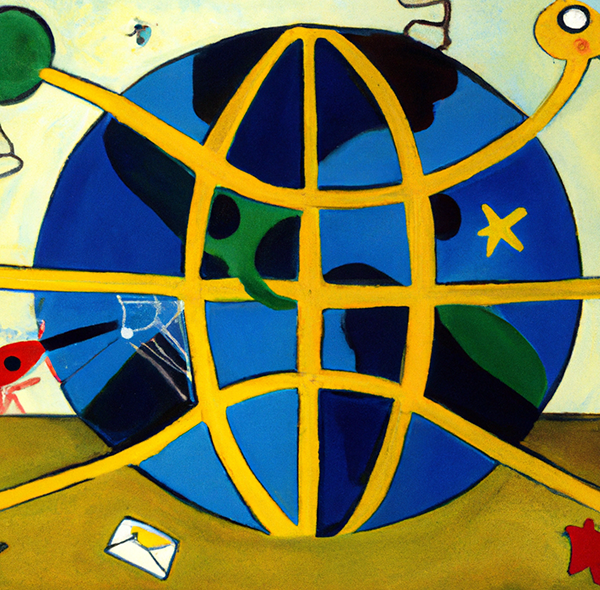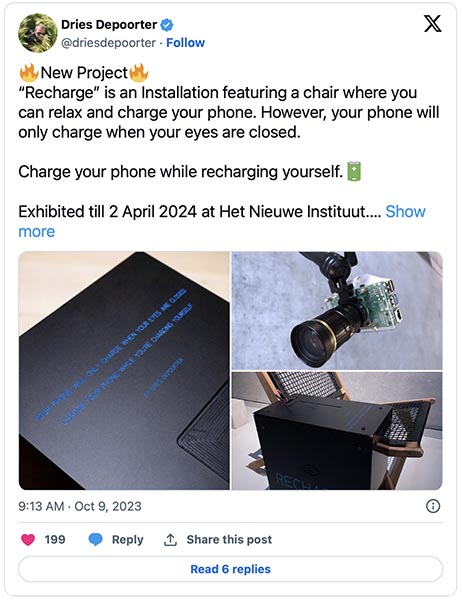
Preaching to the Quire
Via Print magazine, author and paper maker Beth Kephart has written a love letter to paper entitled My Life in Paper.
I was fascinated by hand-making paper, and then my husband gave me marbling paint. Then I started cyanotyping and solar fasting over cyanotypes and Gelli printing underneath them all. It just became something that felt suddenly inherent to me.
… I love making. I love making words. I love making a book. I’m terrified of the process afterward; I will not look at this book now that it’s there. I read from it once, and that’ll be it. But this idea of the letters, the typography stuff in her hands, the paper, and the ink on her fingertips calmed her— I find that to be very true in my own practice. I now don’t think I could write a book without having time in a day to go stitch one.
Johnny Cash-less
Prospect magazine predicts “the end of money,” or at least in the UK.
According to research published in September by UK Finance, a trade association, nearly 22m Britons used cash only once a month or not at all in 2022. Just under one million mainly used cash. Since 2017, payments made by debit cards (including with phones and watches) have overtaken those made in physical cash.
The decline in cash was hastened during COVID, but rose again once the lockdowns eased.
For the first time in a decade, cash payments rose—admittedly only by 7 per cent, but bucking the longer-term trend. Why? UK Finance cites anecdotal evidence that, in a cost-of-living crisis and with inflation for a while into double figures, people were finding it easier to manage their money by paying in cash.
You have to admit, you become more conscious of what things cost if you have to dig through your wallet and come up with the requisite cash rather than just charge it. It’s like highway tolls—ever since the advent of EZ Pass, who knows how much highway tolls are?
But there can be other consequences to a world without cash.
The decline in cash is unwelcome, not just to Piers Corbyn, kings and the Mint’s design team, but to those who, voluntarily or otherwise, don’t have bank accounts. It may also create understandable worries regarding the drift of our digitised societies to a place where our every keystroke, phone call and eyeball roll is digitally harvested—by shady tech bros with shareholders to satisfy or authoritarian rulers with dubious agendas—in ways that would make Big Brother envious.
Would then online platforms like cryptocurrency be the solution, or an even worse alternative? Hah! Whaddaya think?
Consider Amazon’s Mechanical Turk, a (bizarrely named) website owned by the vast retail multinational where humans are employed online to do tasks which, for the time being at least, are not suitable for artificial intelligence. This might include identifying specific content in an image or video, writing product descriptions or answering survey questions. The online ad reads: “Make money in your spare time. Get paid for completing simple tasks.” But, as O’Dwyer points out, thousands of Mechanical Turks without US bank accounts are not paid in cash—they are paid in Amazon gift cards.
This was literally an episode of Black Mirror. Call us crazy, but we suspect cash isn’t going anywhere.
Let Us Spray
Are you a graffiti artist who wants to take public vandalism to the next level? Well, be sure to check out this “Graffiti Color Mixer” created by Ukrainian street artist Vitaly Tesh that includes multiple colors in the same spray can. Huh? Via Laughing Squid:
Now I can make a remote control in a 3D program and print it on a 3D printer. Okay what should be the design of the remote control so that it’s convenient to hold it in one hand and it will be possible to press not only one button but two three or four buttons at the same time to mix colors while painting?
Huh? Anyway, this video clears things up a bit.
Brush with Disaster
Some of you may recall the HBO series Silicon Valley, Mike Judge’s brilliantly funny send-up of tech-bro culture. (Great moment: a self-driving car kidnaps one of the characters and loads him on a container ship bound for Asia.) At any rate, this (via Boing Boing) sounds like it could have been a plot point:
According to Swiss newspaper Aargauer Zeitung, a company was knocked offline by a Distributed Denial of Service (DDoS) attack unleashed by a botnet of three million smart toothbrushes.
Ah, yes, our good old friend The Internet of Things.
Details are vague but warnings around the cybersecurity (or lack thereof) of Internet of Things devices have abounded for more than a decade. Apparently the toothbrushes, running Java, were infected with malware. Hackers then used the devices to create a vast network of WiFi-connected computers that overwhelmed the target company’s Website with requests.
No wonder details were vague: it did not actually happen.
The story is dramatic and definitely newsworthy, if accurate, and began sweeping through other technology news sites yesterday, with numerous publications covering the alleged attack without verifying the story. However, there is one problem with the story—there is no record that this attack ever happened.
Picky picky.
Instead, this was likely a hypothetical scenario shared by Fortinet with the newspaper that was misunderstood or taken out of context to create a story that is widely disputed by security experts.
Imagine if there were no hypothetical scenarios…
Furthermore, electric toothbrushes do not connect directly to the internet but instead use Bluetooth to connect to mobile apps that then upload your data to web-based platforms.
We’re not sure we want anything called Bluetooth associated with our teeth, although it’s better than Blacktooth. Still, we see no reason to have a toothbrush connect to anything but teeth.
Graphene Gets Under Your Skin
Was it a good week for graphene news? It’s always a good week for graphene news! Graphene-based sweat monitoring tattoos. From (who else?) Graphene-Info:
University of Massachusetts Amherst researchers have received an award to develop a graphene-based sweat monitor tattoos that can be applied to the skin just like a temporary tattoo and assess the molecules present, such as cortisol. The tattoos will aim to give users better insight into their health and serve as a tool for researchers to discover new early indications of diseases.
They are indeed sweating the small stuff.
Most existing methods for analyzing sweat are time-consuming and labor-intensive, limiting them to a laboratory setting. Kireev’s design is based on a method that is simple enough for lay people to use, not just trained clinicians. “Current sweat analysis that’s typically done is in clinics is using liquid chromatography mass spectroscopy,” he explains. “These are all refrigerator-sized machines that are amazing—they could measure all your sweat—but you need to swab the sweat sample, store and analyze. The process is slow, and cost-ineffective.”
Road Range
Electric vehicles continue to proliferate, but one barrier to their widespread adoption is a concern over available charging stations. (When the ICE automobile hit the market there were of course gas stations on every corner.) Anyway, via the BBC, the future of EV charging may very well be on display in Detroit: a road that is itself a charging station.
The quarter-mile (400m) section of road through the Corktown area of Detroit is a pilot of a wireless technology that is capable of charging vehicles as they drive over it.
Electromagnetic coils were laid under the surface and connected to the city’s power grid. These create an electromagnetic field just above the road that transfers energy to a receiver attached to a vehicle battery through a process known as “inductive charging”. It is similar to the technology used in wireless charging for mobile phones.

It is not without its own barriers, such as cost (nearly $2 million per mile), although that could come down as the technology scales up. And not every stretch of every road needs a charger.
Nunes agrees that wireless charging roads could be a plausible solution for the medium and heavy duty trucking industry, which he says disproportionately contributes carbon emissions on a per mile basis. “If the vehicle is traveling a fixed route it doesn't deviate that much from, retrofitting these sections of roadway with wireless charging may well make sense,” he says.
And, after all,
the goal is not to replicate a plug-in fast charger. Tongur says Electreon is able to achieve 35kW of dynamic charging per receiver. That means buses or trucks that have three receivers can get up to 100kW while driving. Over several miles, that's potentially a tremendous boost to range, he says, particularly helpful if you're out on a stretch of the road in areas where charging stations are few and far between.
Cool idea.
Face Time
Now, this is not a charger you want installed in roads. Via Boing Boing:
Belgium-based artist Dries Depoorter created this clever art installation titled Recharge. It features “a chair where you can relax and charge your phone. However, your phone will only charge when your eyes are closed.”
Say what?
While you're seated, a camera captures video of your face that’s analyzed in real time by a Raspberry Pi to determine if your eyes are indeed shut. If they are, the mobile charger by the chair is activated.

Hosed
Three words: flying fire hose.
Some of you may be familiar with flyboards, a water sport item that uses water pressure to terrify onlookers propel riders upwards. Comme ça:

Japanese researchers have taken this concept further. Via Core 77:
Reasoning that fire hoses already have tremendous amounts of water pressure on tap, researchers at Japan's Akita Prefectural University have developed a flying, controllable hose for extinguishing fires.
Thus: the Dragon Firefighter.

Flying at two meters above the ground, “the firehose can change shape and be oriented towards flames, steered by a control unit in a wheeled cart behind,” the researchers explain. “The cart is connected through a supply tube to a fire truck with a water reservoir of 14,000 liters.”
Pretty neat, though this sounds a little creepy:
The researchers have built a four-meter-long prototype that they can successfully snake through a window, at least in testing.
The horror movies just write themselves.
Ant Lions
We don’t always appreciate how interconnected nature can be, and how disrupting one bit of it can have consequences far down the line. Case in point: how ant behavior is impacting lions’ hunting prowess. Via Atlas Obscura:
Typically, native acacia ants guard the whistling thorns from elephants, swarming up their nostrils if they try to eat the tree. But those native insects and their young are being eaten by big-headed ants, which “likely were imported from the Indian Ocean in produce bushels,” says Jacob R. Goheen, a wildlife ecologist in the University of Wyoming’s Department of Zoology and Physiology and primary author of the study. That means the trees have become vulnerable to elephants, which have indeed been destroying the infested trees seven times quicker than those protected by the native ants. That’s a problem for the lions, who use the trees as cover to hunt zebras.
So, let’s get this straight. An invasive species—the big-headed ants—are eating the native acacia ants. Because of the lack of acacia anta, elephants—which are normally repelled by acacia ants—are decimating the acacia trees, trees which serve as cover for lions, specifically for lions when they hunt zebras. So the lions have had to switch their prey: to buffalo.
Buffalo are a much more dangerous prey option for lions; it takes a lot of energy, and the buffalo may end up killing the lion first.
So the Kenyan ecosystem is in flux, and it may take more than 20 years for things to sort themselves out.
It’s possible, also, that some other type of vegetative cover could grow that’s better at dealing with elephants than the whistling thorn, which would provide a new space for the lions to stalk their prey. While these proposed possibilities remain to be seen based on more time and research, the invasive ants have certainly impacted the landscape and wildlife in Kenya—and more research will show how all the living creatures in the ecosystem deal with those changes.
Dam It!
Here’s a sentence that piques the interest, via Atlas Obscura: “For decades, people have gone out of their way to move beavers across great distances.” And why would they be doing this?
Initially, beaver relocation was a way to get the rodents out of the way, but it turns out they can positively impact an ecosystem when they are introduced.
Beavers are ecosystem engineers—and the ecosystems they create happen to be key to limiting wildfires and managing drought conditions.
However, transporting beavers is not without its difficulties, such that, at one point, they were deployed by parachute.

[In 1948] beavers were parachuted out of planes in Idaho. Back then, Idaho Fish and Game had loaded the animals into boxes designed to spring open upon landing, and then dropped them over the Sawtooth Mountain Range.
“At the time, when you had a bunch of out-of-work paratroopers post–World War II getting state jobs, and a bunch of airplanes that weren’t being used, and cheap fuel, yeah, that was an affordable option. Not so much today,” says Joe Wheaton, a river restoration expert also at Utah State.
Anyone who’s seen a dam made of sticks knows that water eventually finds its way around and through, so beaver dams just slow water down enough to spread out, pool, soak the soil, and create wetlands. Without beaver dams, rainfall and snowmelt are more likely to rush through a landscape in a narrow channel.
“Take a glass of water and a big sponge,” says Wheaton. “Pour water on that sponge and you can time how long it takes to dry out—it takes a hell of a long time. Get a pair of scissors out, you cut it in half, pour the exact same amount of water, it dries out a lot quicker. Then you cut it up again and again and again. It’s wet for a few minutes and that’s it.” Wheaton says. Beaver dams create bigger sponges.
So how do they move beavers about these days? On horseback. And we’ll let your imagination run wild…
Pickle Ball
Valentine’s Day is fast approaching, which of course means “The State of the Cloud” webinar. But for those who have more (or less, who are we to say?) romantic inclinations, why not say it with pickles? Yes, just in time for everyone’s least favorite Hallmark holiday, Grillo’s Pickles offers the Pickle Bouquet.
Want to let the pickle lover in your life know that you truly understand them? What better way to do so than with a bouquet of pickles?! This make-your-own pickle bouquet kit includes:
- A Grillo’s “free jar” coupon
- Wooden skewers
- Foam base
- Floral filler (oh la la)
- Tissue paper,
- Recipient card and cardholder
- Custom "pickle vase"
Add in a few more of your favorites – cherry tomatoes, cheese cubes, fresh dill – and you have yourself a deal on a dozen roses PLUS a fresh, delicious snack!

Who says true romance is dead?
The 12 Ads of Super Bowl
This weekend is Super Bowl Sunday and, via Food & Wine, “DoorDash Is Giving 1 Lucky Person Every Single Thing Advertised During the Super Bowl — Everything.” That’s a definition of “lucky” with which were unfamiliar. But what specifically will this entail?
DoorDash is keeping a running list of prizes on its All the Ads website and, as of this writing, the food and beverage haul the winner will take home includes 1,000 Popeyes chicken wings (which the company says can be “redeemed at your convenience,” so you don’t have to clear the fridge for all 1,000 pieces); at least 20 family sized packages of Oreos; four 12-packs of Starry; 720 packages of Reese’s peanut butter cups; 80 Drumstick ice cream cones; one 30 pound bucket of mayonnaise; 23 bags of Nerds gummy clusters; 25 cans of Pringles; 288 packages of peanut butter M&Ms; 40 packages of Doritos Dynamita chips; a Budweiser Clydesdale saddle; 60 bottles of Mountain Dew Baja Blast; and a Michelob Ultra cooler. (The winner is also set to pick up at least three actual cars.)
What, no partridge in a pear tree, as well?
Assuming this sounds appealing to you, how do you participate?
To have a shot at winning, well, All the Ads, DoorDash says you’ll need to “crack the code” in its own Super Bowl advertisement and then enter it on the All the Ads website. “Hold your breath, press ‘submit now,’ and keep your fingers crossed,” the company ads.
Or you could enter someone else in it and watch with amusement, à la the Berners Street Hoax.
This Week in Printing, Publishing, and Media History
February 5
1909: Belgian chemist Leo Baekeland announces the creation of Bakelite, the world's first synthetic plastic.
1919: Charlie Chaplin, Mary Pickford, Douglas Fairbanks, and D. W. Griffith launch United Artists.
1924: The Royal Greenwich Observatory begins broadcasting the hourly time signals known as the Greenwich Time Signal.
1926: American publisher Arthur Ochs Sulzberger born.
1940: Swiss painter, sculptor, and set designer (Alien) H. R. Giger born.
February 6
AD 60: The earliest date for which the day of the week is known. A graffito in Pompeii identifies this day as a dies Solis (Sunday). In modern reckoning, this date would have been a Wednesday.
1515: Italian publisher, founded the Aldine Press Aldus Manutius dies (b. 1449).
1756: American colonel and politician, 3rd Vice President of the United States Aaron Burr born. Wait for it.
1945: Jamaican singer-songwriter and guitarist Bob Marley born.
February 7
1497: In Florence, Italy, supporters of Girolamo Savonarola burn cosmetics, art, and books, in a “Bonfire of the vanities.”
1812: English novelist and critic Charles Dickens born.
1885: American novelist, short-story writer, playwright, and Nobel Prize laureate Sinclair Lewis born.
1898: Émile Zola is brought to trial for libel for publishing J'Accuse…!.
1997: NeXT merges with Apple Computer, starting the path to Mac OS X.
February 8
1587: The death of Mary, Queen of Scots (b. 1542).
1828: French author, poet, and playwright Jules Verne born.
1834: Russian chemist and academic, and creator of the Periodic Table of Elements Dmitri Mendeleev born.
1915: D. W. Griffith’s controversial film The Birth of a Nation premieres in Los Angeles.
1922: United States President Warren G. Harding introduces the first radio set in the White House.
1946: The first portion of the Revised Standard Version of the Bible, the first serious challenge to the popularity of the Authorized King James Version, is published.
1971: The NASDAQ stock market index opens for the first time.
1978: Proceedings of the United States Senate are broadcast on radio for the first time.
February 9
1737: English-American philosopher, author, activist, and pamphleteer Thomas Paine born.
1870: US president Ulysses S. Grant signs a joint resolution of Congress establishing the U.S. Weather Bureau.
1881: Russian novelist, short story writer, essayist, and philosopher Fyodor Dostoyevsky dies (b. 1821).
1923: Irish rebel, poet, and playwright Brendan Behan born.
1964: The Beatles make their first appearance on The Ed Sullivan Show, performing before a record audience of 73 million viewers across the US.
1986: Halley’s Comet last appeared in the inner Solar System.
February 10
1890: Russian poet, novelist, literary translator, and Nobel Prize laureate Boris Pasternak born.
1898: German director, playwright, and poet Bertolt Brecht born.
1940: Tom and Jerry make their debut with the cartoon Puss Gets the Boot.
1962: Roy Lichtenstein’s first solo exhibition opens. It includes Look Mickey, which featured his first use of Ben-Day dots, speech balloons, and comic imagery sourcing, all of which he is now known for.
1967: American director, producer, and screenwriter Vince Gilligan born.
1996: IBM supercomputer Deep Blue defeats Garry Kasparov in chess for the first time.
2005: American actor, playwright, and author Arthur Miller dies (b. 1915).
February 11
1650: French mathematician and philosopher René Descartes dies (b. 1596). Guess he didn’t think.
1800: English photographer, politician, and inventor of the calotype Henry Fox Talbot born.
1840: Gaetano Donizetti’s opera La fille du régiment receives its first performance in Paris, France.
1843: Giuseppe Verdi’s opera I Lombardi alla prima crociata receives its first performance in Milan, Italy.
1847: Thomas Edison born.
1909: American director, producer, and screenwriter Joseph L. Mankiewicz born.
1938: BBC Television produces the world’s first ever science fiction television program, an adaptation of a section of the Karel ?apek play R.U.R., that coined the term “robot.”










Discussion
Join the discussion Sign In or Become a Member, doing so is simple and free